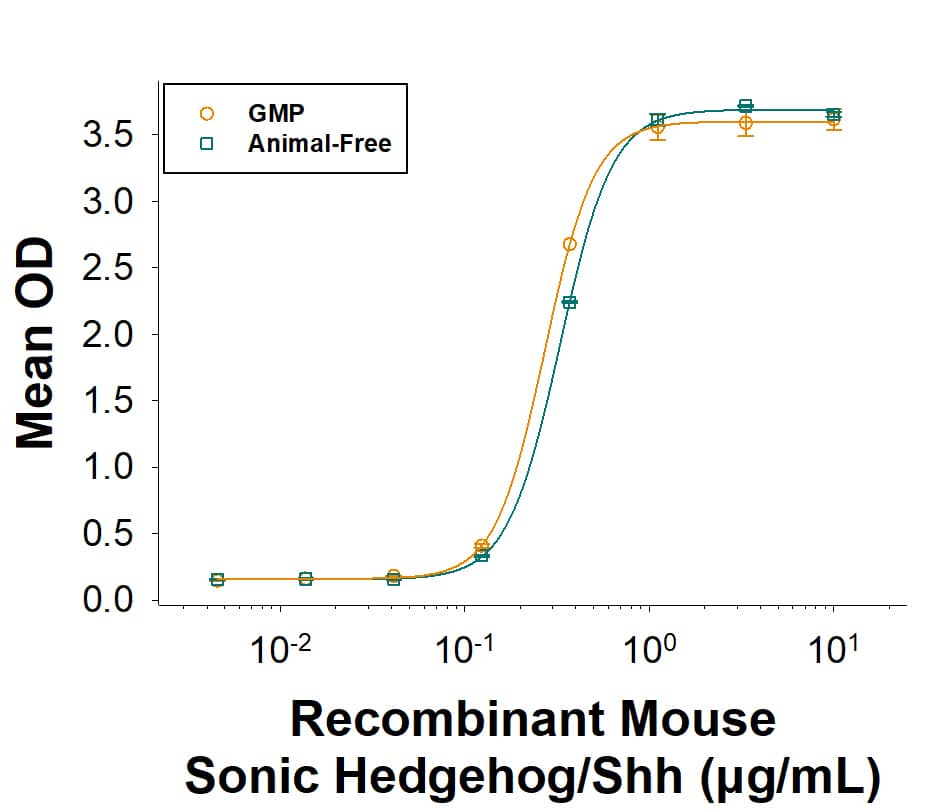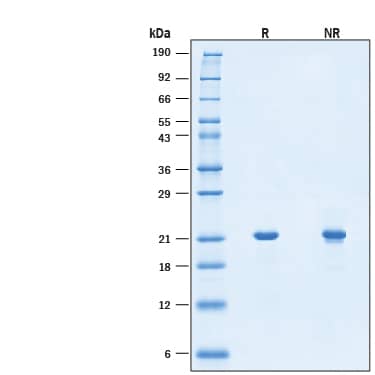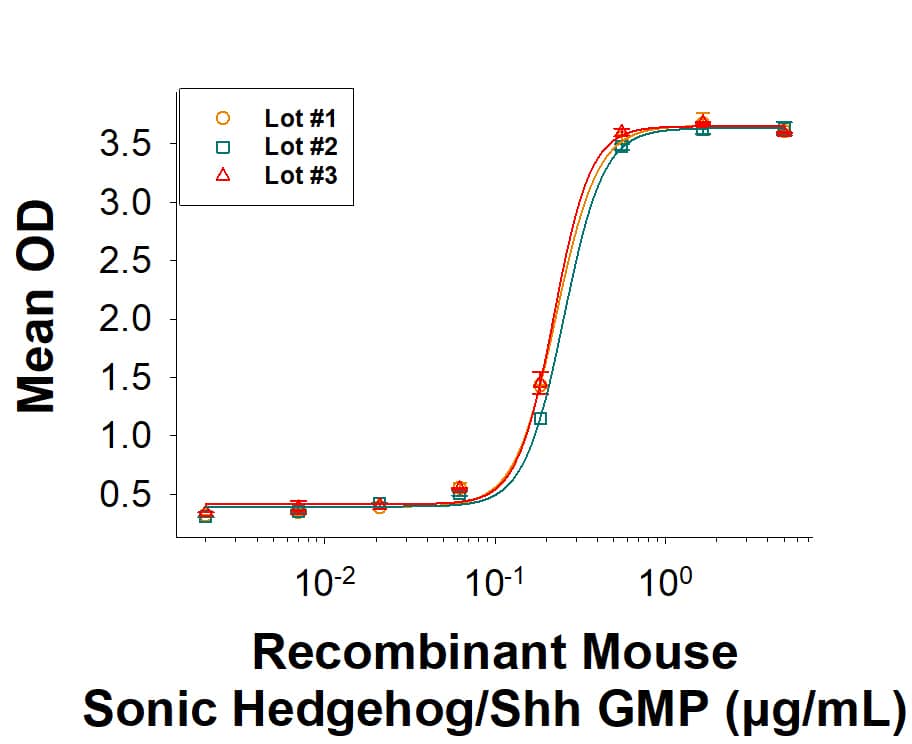Recombinant Mouse Sonic Hedgehog/Shh GMP Protein, CF GMP
R&D Systems, part of Bio-Techne | Catalog # BT-SHH-GMP
Widely used for both human and mouse cell culture.

Key Product Details
- SHH Manufactured in Bio-Techne's new GMP facility
- Lot-to-lot consistency
- Stringent guidelines for patient safety
- Scalability necessary to support successful therapeutics
- Learn more about manufacturing in our new GMP facility
- Test it in your process! Request a sample of GMP SHH
Product Specifications
Source
E. coli-derived mouse Sonic Hedgehog/Shh protein
Cys25 - Gly198 (Cys25Ile-Ile) with an N-terminal Met
Produced using non-animal reagents in an animal-free laboratory.Manufactured and tested under cGMP guidlines.
Cys25 - Gly198 (Cys25Ile-Ile) with an N-terminal Met
Produced using non-animal reagents in an animal-free laboratory.Manufactured and tested under cGMP guidlines.
Purity
>97%, by SDS-PAGE with quantitative densitometry by Coomassie® Blue Staining. The molecular weight by mass spectrometry is 19844 Da ± 26 Da.
Endotoxin Level
<0.10 EU per 1 μg of the protein by the LAL method.
N-terminal Sequence Analysis
Met-Ile-Ile-Gly26-Pro-Gly-Arg-Gly-Phe-Gly
Predicted Molecular Mass
19.8 kDa
SDS-PAGE
21 kDa, under reducing conditions.
Activity
Measured by its ability to induce alkaline phosphatase production by C3H10T1/2 mouse embryonic fibroblast cells. Nakamura, T. et al. (1997) Biochem. Biophys. Res. Commun. 237:465.
The ED50 for this effect is 0.0500-0.600 μg/mL.
The ED50 for this effect is 0.0500-0.600 μg/mL.
Host Cell Protein
<0.500 ng per μg of protein when tested by ELISA.
Mycoplasma
Negative for Mycoplasma.
Host Cell DNA
<0.00150 ng per µg of protein when tested by PCR.
Scientific Data Images for Recombinant Mouse Sonic Hedgehog/Shh GMP Protein, CF
Recombinant Mouse Sonic Hedgehog/Shh GMP Protein Bioactivity.
The bioactivity of Recombinant Mouse Sonic Hedgehog/Shh GMP Protein (Catalog # BT-SHH-GMP) was measured in the alkaline phosphatase production using C3H10T1/2 mouse embryonic fibroblast cells. Three independent lots were tested for bioactivity and plotted on the same graph to show lot-to-lot consistency of GMP Sonic Hedgehog/Shh protein.Equivalent Bioactivity of GMP and Animal-Free grades of Recombinant Mouse Sonic Hedgehog/Shh.
Equivalent bioactivity of GMP (Catalog # BT-SHH-GMP) and Animal-Free (BT-SHH-AFL) grades of Recombinant Mouse Sonic Hedgehog/Shh as measured in the alkaline phosphatase production using C3H10T1/2 mouse embryonic fibroblast cells (orange and green, respectively).Recombinant Mouse Sonic Hedgehog/Shh GMP Protein SDS-PAGE.
2 μg/lane of Recombinant Mouse Sonic Hedgehog/Shh GMP Protein (Catalog # BT-SHH-GMP) was resolved with SDS-PAGE under reducing (R) and non-reducing (NR) conditions and visualized by Coomassie® Blue staining, showing a band at 21 kDa.Formulation, Preparation and Storage
BT-SHH-GMP
| Formulation | Lyophilized from a 0.2 μm filtered solution in Sodium Phosphate, NaCl and DTT with Trehalose. |
| Reconstitution | Reconstitute at 500 μg/mL in sterile water. |
| Shipping | The product is shipped with polar packs. Upon receipt, store it immediately at the temperature recommended below. |
| Stability & Storage | Use a manual defrost freezer and avoid repeated freeze-thaw cycles.
|
Background: Sonic Hedgehog/Shh
N-terminal cysteine and modified by cholesterol addition at its C-terminus (6). These modifications contribute to the membrane tethering of Shh as well as its assembly into various sized multimers (6-9). Lipid modification and multimerization greatly increase Shh-N receptor binding affinity and signaling potency (5, 6, 8, 9). Monomeric and multimeric Shh can be released from the plasma membrane by the cooperative action of DISP1, SCUBE2, and TACE/ADAM17 (10-12). Modifications also extend the effective range of Shh functionality and are required for the development of protein gradients important in tissue morphogenesis (9, 13). Canonical signaling of Shh is mediated by a multicomponent receptor complex that includes Patched (PTCH1, PTCH2) and Smoothened (SMO) (14). The binding of Shh to PTCH releases the basal repression of SMO by PTCH. Shh activity can also be regulated through interactions with heparin, glypicans, and membrane-associated Hip (hedgehog interacting protein) (13, 15, 16).
References
- Briscoe, J. and P.P. Therond (2013) Mol. Cell. Biol. 14:416.
- Aviles, E.C. et al. (2013) Front. Cell. Neurosci. 7:86.
- Xie, J. et al. (2013) OncoTargets Ther. 6:1425.
- Echelard, Y. et al. (1993) Cell 75:1417.
- Zeng, X. et al. (2001) Nature 411:716.
- Feng, J. et al. (2004) Development 131:4357.
- Goetz, J.A. et al. (2006) J. Biol. Chem. 281:4087.
- Pepinsky, R.B. et al. (1998) J. Biol. Chem. 273:14037.
- Chen, M.-H. et al. (2004) Genes Dev. 18:641.
- Etheridge, L.A. et al. (2010) Development 137:133.
- Jakobs, P. et al. (2014) J. Cell Sci. 127:1726.
- Dierker, T. et al. (2009) J. Biol. Chem. 284:8013.
- Lewis, P.M. et al. (2001) Cell 105:599.
- Carpenter, D. et al. (1998) Proc. Natl. Acad. Sci. USA 95:13630.
- Filmus, J. and M. Capurro (2014) Matrix Biol. 35:248.
- Chuang, P.-T. and A.P. McMahon (1999) Nature 397:617.
Alternate Names
HHG1, HLP3, HPE3, MCOPCB5, Shh, ShhNC, SMMCI, TPTPS
Gene Symbol
SHH
UniProt
Additional Sonic Hedgehog/Shh Products
Product Documents for Recombinant Mouse Sonic Hedgehog/Shh GMP Protein, CF
Manufacturing Specifications
GMP ProteinsR&D Systems, a Bio-Techne Brand's GMP proteins are produced according to relevant sections of the following documents: USP Chapter 1043, Ancillary Materials for Cell, Gene and Tissue-Engineered Products and Eu. Ph. 5.2.12, Raw Materials of Biological Origin for the Production of Cell-based and Gene Therapy Medicinal Products.
R&D Systems' quality focus includes:
- Designed, manufactured and tested under an ISO 9001:2015 and ISO 13485:2016 certified quality system
- Documented and controlled manufacturing process
- Control of documentation and process changes by QA
- Personnel training programs
- Raw material inspection and vendor qualification/monitoring program
- Validated equipment, processes and test methods
- Equipment calibration and maintenance schedules using a Regulatory Asset Manager
- Facility/Utilities maintenance, contamination controls, safety and pest control programs
- Material review process for variances
- Robust product stability program following relevant ICH guidelines
- N-terminal amino acid analysis
- SDS-PAGE purity analysis
- Molecular weight analysis via mass spectrometry
- Endotoxin assessment per USP <85> and Ph. Eur. 2.6.14 guidelines
- Bioassay analysis
- Microbial testing per USP <71> and Ph. Eur. 2.6.1 guidelines
- Host cell protein assessment
- Host cell DNA assessment
- Mycoplasma assessment
Production records and facilities are available for examination by appropriate personnel on-site at R&D Systems in Minneapolis and St. Paul, Minnesota USA.
R&D Systems sells GMP grade products for preclinical or clinical ex vivo use. They are not for in vivo use. Please read the following End User Terms prior to using this product.
Animal-Free Manufacturing Conditions
Our dedicated controlled-access animal-free laboratories ensure that at no point in production are the products exposed to potential contamination by animal components or byproducts. Every stage of manufacturing is conducted in compliance with R&D Systems' stringent Standard Operating Procedures (SOPs). Production and purification procedures use equipment and media that are confirmed animal-free.
Production
- All molecular biology procedures use animal-free media and dedicated labware.
- Dedicated fermentors are utilized in committed animal-free areas.
- Protein purification columns are animal-free.
- Bulk proteins are filtered using animal-free filters.
- Purified proteins are stored in animal-free containers.
Product Specific Notices for Recombinant Mouse Sonic Hedgehog/Shh GMP Protein, CF
Full terms and conditions of sale can be found online in the Protein Sciences Segment T&Cs at: Terms & Conditions.
For preclinical, or clinical ex vivo use
